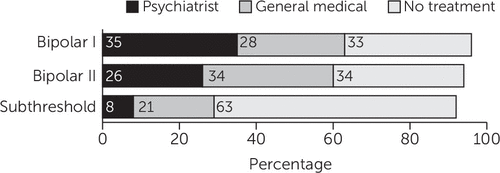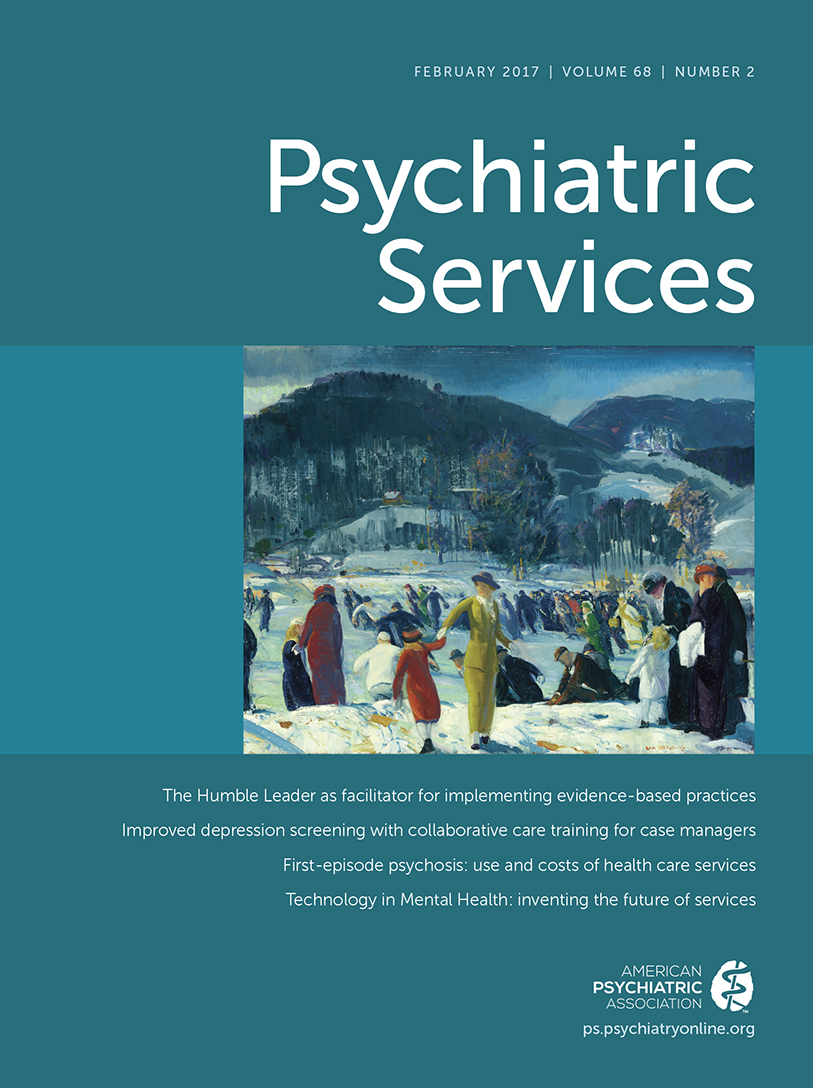Bipolar Disorder and Population Health
Abstract
This Open Forum addresses considerations for improving treatment of bipolar disorder. Most individuals with bipolar disorder report not receiving treatment from a psychiatrist in the past 12 months. In the United States, a large proportion of persons with bipolar disorder seek treatment in primary care. These patients have high symptom severity and functional impairment but are less likely to receive mood-stabilizing medications. In a prior study in a primary care setting, the authors found that one-third of patients with bipolar disorder improved after receiving treatment in primary care in a statewide collaborative care program. The collaborative care approach, originally developed for treating patients with depression in primary care, may need to be strengthened or adapted for treating patients with bipolar disorder. Strategies such as telehealth or enhanced collaborative care that also addresses psychosocial needs may be needed to effectively treat patients with bipolar disorder seeking treatment in primary care.
Bipolar disorder has a lifetime prevalence of 4.4% in the general population, or approximately 14 million individuals in the United States on the basis of 2015 population estimates (1). The prevalence of bipolar disorder is similar for men and women and across races and ethnicities (1). Incident bipolar disorder often occurs in late adolescence, providing an opportunity for intervention and sustained management over many years in adulthood. However, detection remains a problem, and of persons eventually given a diagnosis, an average of six to eight years passes between symptom onset and diagnosis (2). Many individuals with bipolar disorder experience chronic symptoms, and bipolar disorder remains a leading cause of disability in the United States. A significant need exists to improve the health of the population—or entire group—of individuals with bipolar disorder.
What Proportion of Individuals With Bipolar Disorder Receives Treatment?
Findings published in 2007 showed that almost all individuals with bipolar I or II disorder (89% and 95%, respectively) received treatment for bipolar disorder at least once during their lifetime, and approximately two-thirds had ever received treatment from a psychiatrist (1). However, the picture is different for receipt of treatment during the past 12 months. Figure 1 shows the setting in which individuals with bipolar disorder reported receiving treatment in the past 12 months. About one-third of individuals with bipolar I or II disorder reported not receiving treatment for bipolar disorder in the past 12 months (1). Individuals who received treatment were about equally divided between those who received treatment from a psychiatrist and those who received treatment from a general medical clinician, such as a primary care clinician (1). Among persons with subthreshold bipolar disorder, an even smaller proportion received treatment. In the past 12-month period, two-thirds of individuals with subthreshold bipolar disorder reported not receiving any treatment, and only 8% received treatment from a psychiatrist.

FIGURE 1. Treatment setting in past 12 months for 262 individuals with bipolar I or bipolar II disorder or subthreshold bipolar disordera
a Percentages do not sum to 100% because some individuals reported treatment in other sectors, such as human services.
Although many patients with bipolar disorder seek care in general medical settings, few receive effective medication treatment. Many patients in primary care often receive no medication treatment or treatment with medications other than mood-stabilizing medications, such as antidepressant medications (1,3). Antidepressant use by individuals with bipolar disorder remains controversial; effective use has been shown for some patients with bipolar II disorder (4). However, a recent consensus statement recommended avoiding use of antidepressant medications by individuals with bipolar depression who are concurrently experiencing two or more manic symptoms (5), which the STEP-BD study showed occurred for approximately half of patients with bipolar depression (6).
Not receiving effective medication treatment is a significant problem, because individuals with bipolar disorder often experience chronic but treatable symptoms. Individuals followed for an average of 12 years experienced symptoms approximately half of the weeks during the study period, with depressive symptoms occurring significantly more often than manic or hypomanic symptoms (7). Presence of depressive symptoms is associated with recurrence of a mood episode among individuals with bipolar disorder (8), suggesting that treatment of residual depressive symptoms could reduce the incidence of mood episode recurrence. For individuals with bipolar disorder who have not received treatment or who have received ineffective medication treatment over the past 12 months, opportunities may have been missed for adjusting or intensifying treatment to manage recurrent or chronic symptoms.
How Can a Greater Proportion Receive High-Quality Treatment?
Because many patients are seen only in this setting in a 12-month period (1), one option for improving the health of individuals with bipolar disorder is improving the quality and intensity of mental health care in the general medical setting. Furthermore, office visits resulting in a diagnosis of bipolar disorder increased more rapidly in primary care settings compared with specialty mental health settings from 1995 to 2010 (9). Medication treatment is usually necessary in the provision of high-quality care to individuals with bipolar disorder and could be offered in primary care settings. Improving patients’ well-being will also require determining how to effectively address the psychosocial needs of patients with bipolar disorder in primary care (10). However, there are currently numerous barriers that prevent primary care clinicians from prescribing mood-stabilizing medications and limited resources to address psychosocial needs in primary care settings.
To understand how to improve the quality of care delivered in primary care, we explored the characteristics of 740 primary care patients with bipolar disorder (11). We found that patients had an average symptom burden of moderately severe depressive symptoms, co-occurring symptoms of posttraumatic stress disorder, and substance use problems (11). Fifty-seven percent had ever received treatment from a psychiatrist, and one-third had one or more prior psychiatric hospitalizations. Current suicidal ideation was present in over half the sample, and about 10% reported homelessness (11). This is consistent with prior findings that patients with bipolar disorder in primary care have significant symptom severity and psychosocial impairment similar to patients seen in mental health settings (12).
Patients in our study were receiving treatment from primary care clinicians assisted by a psychiatrist and a care manager using a collaborative care model intended to treat patients with depression. Collaborative care treatment includes team-based care that offers multiple opportunities for patient assessment, symptom measurement, and treatment intensification (guided by a consulting psychiatrist) for patients who are not achieving treatment targets. Even though the patients in our primary care sample were supported by a care manager and psychiatrist and had an average treatment duration of 30 weeks, we found that only 33% experienced significant clinical improvement (11).
Future Directions
Improving mental health outcomes for the entire population of individuals with bipolar disorder will need to include effective identification and treatment of patients in primary care settings. Detection of bipolar disorder by use of structured screening measures supplemented with additional clinical information may be feasible in some primary care settings (11,13). Accurately identifying primary care patients with bipolar disorder could help provide patients with higher-quality care, such as treatment with mood-stabilizing medications and psychotherapy. For patients seen only in primary care, it will be important to develop strategies for intensifying treatment when residual depressive or manic symptoms or mood episodes are present.
The collaborative care approach originally developed for treating patients with depression in primary care may need to be strengthened and adapted for treating patients with bipolar disorder. Two options for doing this could be direct consultation with a psychiatrist during initial treatment stages or direct medication management by a psychiatrist, perhaps by using tele–health care technologies to provide high-quality treatment in primary care. In addition to providing initial psychiatric consultation, it will also be necessary to ensure frequent opportunities for changing or intensifying treatment, including use of psychotherapy, in order to address persistent depressive and other symptoms commonly found among patients with bipolar disorder.
1 : Lifetime and 12-month prevalence of bipolar spectrum disorder in the National Comorbidity Survey Replication. Archives of General Psychiatry 64:543–552, 2007Crossref, Medline, Google Scholar
2 : Failure and delay in initial treatment contact after first onset of mental disorders in the National Comorbidity Survey Replication. Archives of General Psychiatry 62:603–613, 2005Crossref, Medline, Google Scholar
3 : Characteristics of patients with bipolar disorder managed in VA primary care or specialty mental health care settings. Psychiatric Services 61:500–507, 2010Link, Google Scholar
4 : Short-term venlafaxine v lithium monotherapy for bipolar type II major depressive episodes: effectiveness and mood conversion rate. British Journal of Psychiatry 208:359–365, 2016Crossref, Medline, Google Scholar
5 : The International Society for Bipolar Disorders (ISBD) task force report on antidepressant use in bipolar disorders. American Journal of Psychiatry 170:1249–1262, 2013Link, Google Scholar
6 : Manic symptoms during depressive episodes in 1,380 patients with bipolar disorder: findings from the STEP-BD. American Journal of Psychiatry 166:173–181, 2009Link, Google Scholar
7 : The long-term natural history of the weekly symptomatic status of bipolar I disorder. Archives of General Psychiatry 59:530–537, 2002Crossref, Medline, Google Scholar
8 : Predictors of recurrence in bipolar disorder: primary outcomes from the Systematic Treatment Enhancement Program for Bipolar Disorder (STEP-BD). American Journal of Psychiatry 163:217–224, 2006Link, Google Scholar
9 : Trends in office-based mental health care provided by psychiatrists and primary care physicians. Journal of Clinical Psychiatry 75:247–253, 2014Crossref, Medline, Google Scholar
10 : Adjunctive psychotherapy for bipolar disorder: state of the evidence. American Journal of Psychiatry 165:1408–1419, 2008Link, Google Scholar
11 : Bipolar disorder in primary care: clinical characteristics of 740 primary care patients with bipolar disorder. Psychiatric Services 65:1041–1046, 2014Link, Google Scholar
12 : Quality of life among patients with bipolar disorder in primary care versus community mental health settings. Journal of Affective Disorders 146:100–105, 2013Crossref, Medline, Google Scholar
13 : The mistaken claim of bipolar “overdiagnosis”: solving the false positives problem for DSM-5/ICD-11. Acta Psychiatrica Scandinavica 126:395–401, 2012Crossref, Medline, Google Scholar



